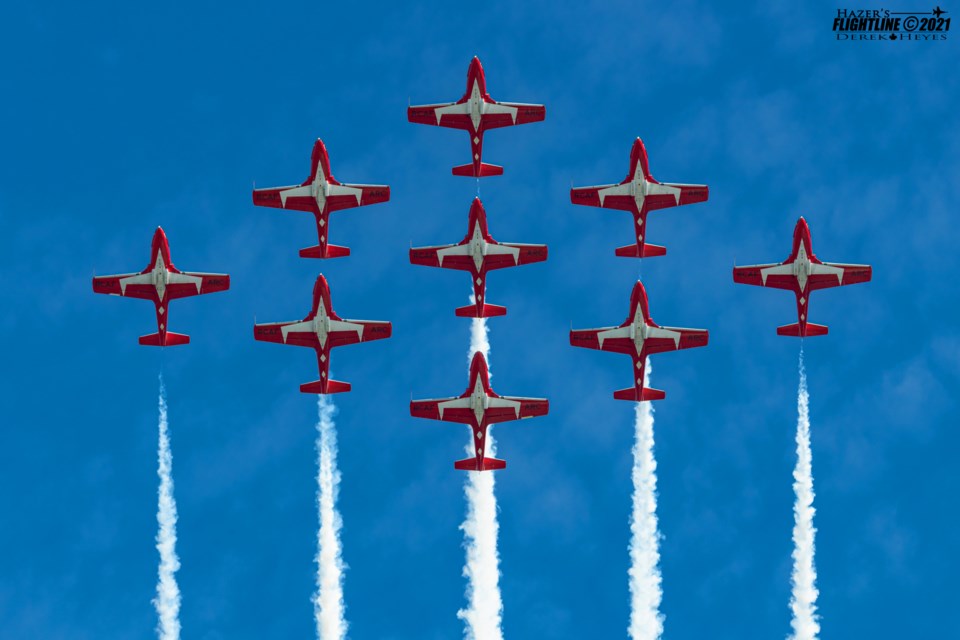LCol (Ret.) Dan Dempsey flew two tours with the Snowbirds and wrote A tradition of excellence: Canada's airshow team heritage (2002/2007) about the history of air demonstration teams in the country.
The Snowbirds Golden Anniversary starts Oct. 20 in Moose Jaw, organized by the Snowbirds Alumni Association, an organization Dempsey founded in 2013.
Dempsey was happy to reveal that, weather permitting, the Snowbirds will do a Moose Jaw flyover on Friday, Oct. 21, from 11:45 a.m. to 12:15 p.m. as a gesture of gratitude to the city.
In this guest column, Dempsey discusses the illustrious history of air demonstration teams in Canada and the Snowbirds in particular — starting right here in Moose Jaw.
I’m LCol (Ret.) Dan Dempsey. I flew two tours with the Snowbirds, I was Snowbird 9 in 1980 and ’81. And then I commanded and led the team in the years 1989 and 1990 — the latter being our 20th anniversary.
That was 32 years ago now. I’ve been heavily involved with the history of the team ever since. I’m also the author of A tradition of excellence: Canada’s airshow team heritage, which chronicles the entire history of Canada’s airshow teams dating all the way back to 1929.
Writing that book was a long journey. It took over seven years to do the first edition, and then about another year to add another five years of history.
I’m glad I wrote it, because Canadians are usually amazed by the fantastic heritage we have in this country when it comes to airshow teams.
Most people alive today have only seen the Snowbirds. But older folks, say 65 and older, may remember the RCAF Golden Hawks from 1959 to ’63. They set the stage for the future of military air demonstration in Canada.
Or the Canadian Armed Forces Golden Centennaires, a team that set a record in 1967 for the most airshows flown, to celebrate our 100th birthday in Canada. They flew 121 shows in a single season — an incredible feat.
Then, there was another solo performer, in a brilliant scarlet-red T-33, called the Red Knight. The Red Knight flew over 600 shows in Canada over a 12-year period, from 1958 to 1969.
These were the predecessors of the Snowbirds. And the Snowbirds were born right here in Moose Jaw.
Col. O.B. Philp was base commander of CFB Moose Jaw starting in 1969, but the key was that he had been a wing commander in the RCAF who was appointed to command the Golden Centennaires.
When O.B. came back to Moose Jaw, he saw some white Tutors on the line — which turned out to be his ex-Golden Centennaire aircraft. And the wheels began turning.
In 1971, he started an unofficial seven-plane airshow team. They were non-aerobatic, but they flew a good, tight formation. On July 11, 1971 they flew as the Snowbirds for the first time at the Saskatchewan Homecoming Airshow, the largest single day airshow in North America.
In 1972, they expanded to nine aircraft, and we went on from there. The original team leader was Maj. Glen Younghusband, handpicked by Col. Philp.
In 1973-74, the team took major steps forward. When Maj George Miller took over the team, he was able to get authorization to do formation aerobatics. That was also the year they introduced the beautiful paint scheme that the team still employs to this day.
So, 1974 was a pivotal year. It was also by 1974 that the team had built such a reputation for competence that George was allowed to introduce formation changes within the aerobatic maneuvers themselves.
George was an ex-Golden Hawk, and the base commander at the time was another ex-Golden Hawk, Col. Ralph Annis. This is why they were able to push the team forward given their extensive aerobatic experience.
Finally, in 1978, for the very first time in Canadian history, the Snowbirds were awarded squadron status as 431 Air Demonstration Squadron.
431 was a very famous squadron. It was a bomber squadron in World War Two. Born, like many of our squadrons, in Europe, and flying with the RCAF's No. 6 Bomber Group. They flew mainly Halifax and Lancaster heavy bombers.
On that note, we are very privileged to have an Honorary Snowbird joining us who flew one of those bombers.
Honorary Snowbird is a title we have awarded over the years to people who have been helpful to us or who have a significant tie to the Snowbirds.
Flt. Lt. Reg Harrison is 99 years old and remains very spry. He is absolutely thrilled to be coming down for the reunion, and he will be our senior alumni association member this weekend.
Snowbirds Statistics
Over the last 52 years, the team has flown 2,757 official shows — at just about every major air show in North America.
Our spectator count is well in excess of 150 million since 1971. The team has flown at 435 different locations, all the way down to Mexico.
We’ve had 205 demonstration pilots, 27 team leaders, and 50 team co-ordinators — those are the pilots who co-ordinate our schedules, fly the spare aircraft from location to location, do the narration and act as safety pilots, a critical role.
The Snowbirds have employed a total of about 500 technicians since their inception, wearing the blue flight suits and maintaining the aircraft. We’re very proud of those technicians.
The Snowbirds are a public relations unit. Their job is to be ambassadors, if you will, for the Canadian Armed Forces and for the entire country. The team enjoys a solid reputation all over the world for its precision flying and aerobatics.
I’m very grateful to have been a member of the Snowbirds, as are the hundreds of alumni members joining us this weekend in Moose Jaw to celebrate our Golden Anniversary.
Those wanting to take a deeper dive into Canada's military air demonstration history can find Dempsey's book at the Western Development Museum Gift Shop, or on his website canadasairshowheritage.com.




